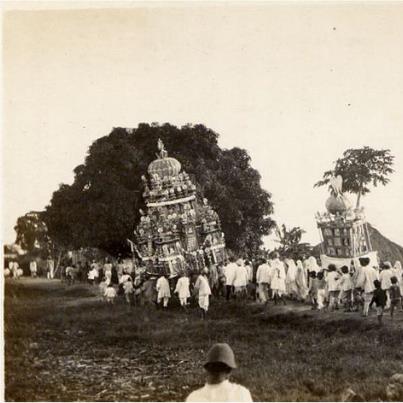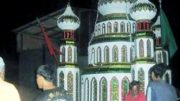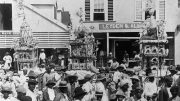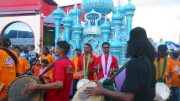The Hosay Massacre (also called the Jahaji or Mohurrun ) of October 30th 1884 is a dark episode in local history. The boisterous commemoration of the martyrdom of Mohammed’s nephews, Hosein and Hassan, came to Trinidad in the 1850’s with the indentured immigrants from India and was first celebrated on Palmiste Estate near San Fernando. A facsimile of the martyrs’ tomb in Kerbala would be assembled of bamboo, tinsel and cloth and the finished Taja would often tower as high as thirty feet. Amidst much drumming and festivity, the gaudy taja would be carried in high procession to the sea or an estate pond and ‘drowned’.
Despite being of Islamic origin, Hosay was celebrated by all on the estate including the negro panboilers and with the exception of the white plantocracy. The 1880’s were a time of unrest. In 1881, a riot erupted at Cedar Hill estate which resulted in the assault of the overseer and requiring the intervention of the police before it was quelled. The growing numbers of Indians in the colony was a source of worry to colonial authorities who feared a mass uprising. The government , through the indomitable Inspector Commandant of Police , Captian Arthur Wybrow Baker , issued an ordinance which would prevent the Hosay processions from the estates from entering the town of San Fernando , which was done so that the tajas may be dumped near King’s Wharf .
On the eve of Hosay, police reinforcements were stationed at the Court House on Harris Promenade while a shipload of Marines, the HMS Dido anchored offshore. It is recorded that some of the Indians on particular estates did not participate in the processions which would approach Royal Road through Mon Repos Estate, and Cipero Cross (Cross Crossing).On October 30th files of armed policemen were stationed at these strategic points to await the eight or ten thousand strong who would defy the Ordinance. It is possible that the Indians did not believe that the police would fire, but upon approaching the barricade at Cipero Cross, Stipendary Magistrate Arthur Child read the riot act and the police fired into the throng. A similar scene occurred almost simultaneously at the junction of Circular Road and Royal Road and when the acris smoke cleared, eleven lay dead and over one hundred were seriously wounded. The tajas were abandoned as carts took the dead to Paradise Cemetery where they were buried in a mass grave upon which the present-day San Fernando Central Market now stands. It is said by some that the hasty internment was done to hide a much greater death toll. This bloody chapter of our history must always stand as a monument to the sovereignty of religious freedoms and the immense sacrifice made by those whose lives were given for this cause.
HISTORICAL ACCOUNT OF J.H COLLENS 1885
The two chief Mussulman sects are the Shiahs and the Sunnis. The former especially reverence Hassan and Hosein, the two sons of Ali, in whose honour are their greatest festivals, and to celebrate the events of whose lives they even perform mysteries, or passion plays, in Persia. The Sunnis, for their part, do not reverence them, but merely recognise them as holy men. Both sects anticipate the coming of a great ‘Mahdi,’ who will set right all wrongs and restore peace and happiness to the universe ; but the Sunnis expect him more as a conqueror than a peacemaker. Knowing this, it is easy to understand the infatuation and adoration of the Mussulmans in the Soudan for their ‘ Mahdi.’ No wonder poor Gordon was so anxious to ‘ smash ‘ him.
Much importance is attached by the Coolies to the yearly festival of the ‘ Mohurran,’ or, as it is better known here, the ‘ Hosein.’ The ‘ Ashura,’ or last day of the Mohurran, is, above all, held in the greatest respect by the Shiahs, as it is intended to commemorate the death of Hosein, the son of Fatima and Ali. The Sunnis do not believe in the ‘ Hosein,’ and five or six years ago the chief of the sect in Trinidad petitioned the Government to put down the Taziya procession, on the ground that it was an insult to their religion, having on several occasions led to riot and murder, and that at the best it was but a foolish ceremony. By way of explanation, I may here remark that the Coolies make Taziya, houses of cardboard ornamented with tinsel and coloured paper, modelled to represent the tomb of Hosein, and, placing these in carts or on the heads of men, march about with them, beating tomtoms and shouting ‘ Hosein.’
Each estate has its Taziya, jealously guarded by the labourers who have helped, either by subscription or otherwise, to construct it. All the estates in the same locality join together, and form up in procession, sometimes serious quarrels and fights taking place at this stage of the proceedings. Having paraded for some time, with dancing, cries of ‘Hosein, Hassan,’ etc., they at length repair to the sea, if practicable—if not, to the nearest body of water—and, throwing their Taziyas into it, the ceremony is ended. The Government did not accede to the petition of the Sunnis referred to above, but placed certain restrictions upon the festival.These new regulations being highly unpalatable, and looked upon by the Orientals as an infringement of their privileges, riots ensued, which were promptly suppressed, though unfortunately not without loss of life. For some time the relations between the Indian immigrants and the authorities were of a very strained nature, but happily things have righted themselves, and for the last few years the ‘ Hosein ‘ has passed off in a most orderly manner. It will be seen that this is essentially a Mohammedan festival, that it is confine to a very small section of the faithful, and that the Hindus have nothing in the world to do with it. Nevertheless, either because it affords them an excuse for a holiday, and therefore for unlimited rum-drinking, or perhaps from sheer ignorance, they join in it with as much zest and earnestness as if it bore a religious significance to them.
The Origins of Hosay
The event marks the anniversary of the Battle of Karbala when Imam Hussain ibn Ali, the grandson of the Islamic prophet Muhammad, and a Shia Imam, was killed by the forces of the second Umayad caliph Yazid I. The event is marked by arranging ‘majalis’ (gatherings) to review Islamic teachings and to commemorate Imam Hussain’s sacrifice. One form of mourning is the theatrical re-enactment of the Battle of Karbala. In Iran this is called taziya or taziyeh. Theatrical groups that specialize in taziya are called taziya groups.
The People
In order to fill the labour gap left by emancipation in 1834, thousands of indentured immigrants from India begin arriving in Trinidad in 1845. They are offered cash incentives to settle in the colony between 1860 and 1880, providing a stable workforce and peasant class which comprises 30% of the population by 1880. The ratio of males :females is almost 4:1 and the majority of the males are youths between the ages of 18-35. The Indians keep largely to themselves and have little social interaction with other races, thus retaining their own customs and lifeways which are at odds with the rule of law in a British colony. Although the majority are Hindus, a small and vibrant Shia Muslim community exists, and annually commemorates Hosay which is first celebrated on Phillippine Estate in 1850 , and rapidly becomes a multi-ethnic, quasi-religious community observance in the Naparimas.
In order to fill the labour gap left by emancipation in 1834, thousands of indentured immigrants from India begin arriving in Trinidad in 1845. They are offered cash incentives to settle in the colony between 1860 and 1880, providing a stable workforce and peasant class which comprises 30% of the population by 1880. The ratio of males :females is almost 4:1 and the majority of the males are youths between the ages of 18-35. The Indians keep largely to themselves and have little social interaction with other races, thus retaining their own customs and lifeways which are at odds with the rule of law in a British colony. Although the majority are Hindus, a small and vibrant Shia Muslim community exists, and annually commemorates Hosay which is first celebrated on Phillippine Estate in 1850 , and rapidly becomes a multi-ethnic, quasi-religious community observance in the Naparimas.
The Setting
San Fernando, capital and commercial centre of the sugar-rich Naparimas is the point at which tajahs from the estates are dumped into the sea during Hosay. The town itself is fairly vulnerable to unrest, having a police force of only 40 men for its population of 9,000 persons. In 1881, a series of violent strikes rock the Naparimas. During the Hosay celebrations of that year, Harrackisingh, a sirdar or sub-overseer is beaten to death in a scuffle at San Fernando. Shortly thereafter, during a strike at Cupar Grange, a white overseer is chopped dead by unruly Indians who are acquitted by the district magistrate. In 1882, strikes plague Cedar Hill , Bronte, Jordan Hill and other estates. At Cedar Hill, the manager, C.D McLean, is attacked with sticks. He hides and summons the police who arrest the dissidents who are also acquitted by the stipendary magistrate. Many overseers were young Irish and Scotsmen who did not know how to manage immigrant labour, and often gained reputations for cruelty, injustice and abuse-especially with regard to Indian women.
The Indian Festivals Ordinance 1882
The Ordinance empowers Governor Sir Sanford Freeling to regulate Indian celebrations including Hosay which is recognized as the single largest expression of public solidarity of the labouring class Indians (and to a lesser extent, negroes) of the colony. On 30th July 1884, the Governor proclaims a regulation prohibiting Hosay processions from the high roads of the colony, thus preventing the Naparima celebrations from entering San Fernando. Hosay is permitted on the estates where tajahs may be drowned in ponds and rivers. The sword-stick or hakka, was expressly prohibited by the Festivals Ordinance of 1882-1884 Amendment. Stickfights were an important part of Hosay observances since they commemorated the military struggles of Hoosein and Hassan against the Umyad Caliphate. Prohibition of the hakka sticks (and also cutlasses) from being carried on the high roads of the colony eliminated a major component of the festival.
A penalty of six months imprisonment with hard labour and a fine of 20 pounds is imposed for those found infringing the Ordinance.
The ordinance is met with dismay. Sookoo, a sirdar of Philippine Estate and others petition Colonial Secretary John Scott Bushe for a repeal of the regulations. Bushe, though sympathetic, declines which seeds anger among the Indians. Police , under Inspector General of the Constabulary, Capt. Arthur Wybrow Baker are placed on high alert. Captain Arthur Wybrow Baker of the Royal Irish Constabulary, who became Inspector General of the Trinidad Constabulary in 1880. He was feared by the lower classes for his no-nonsense, zero-tolerance approach to disorder and his quickness to use force as a means of suppression.
During the Cannboulay Riots in Port-of-Spain in 1882, his policemen were armed only with cudgels and were severely beaten by rioters. When unrest among the Indians began in 1881-82, he was determined to use deadly force against any future dissidents.
His men were armed with Enfield Carbines which were short-range guns , each loaded with 20 rounds of buckshot. They were the preferred firearms for dealing intense and fatal impact across a short distance, which is why the police and troops under Baker’s command during the Hosay Massacre of 1884 waited until the processions were 100 feet or less away from the barricades before opening fire. Baker came under sharp criticism from investigative Commissioner, Sir. H.W Norman for his heavy-handed measures.
Indians and government are on a collision course.
Heading towards a clash:October 1st-25th 1884
On many estates, tajahs are being constructed in preparation for open defiance of the Ordinance. A week before the festival, a clandestine meeting of ringleaders from seven estates takes place at night in the St. Clement’s churchyard cemetery near Ste. Madeline. Not all of the Naparima estates participated. At Ste. Madeline, managers destroyed tajahs which caused immigrants to take to other nearby estates like Golconda to help in their celebrations. Canaan was one of many estates where the Indians were incensed by Sookoo, the primary ringleader of the Hosay Massacre. Sookoo, a sirdar (headman) at nearby Philippine Estate, rallied people to his intended defiance of the Indian Festivals Ordinance by chanting ‘Galbahoga, galbahoga’…’There will be mutiny’. Tajahs in the Naparimas were taller than those from St. James (the later place of Hosay fame) because electric powerlines would not be installed in San Fernando until 1923.
Other managers were more politic. At Diamond, Paul Vessiny, an old experienced French Creole, took upon his own purse the expense of the tajah and entire Hosay celebration provided that the labourers remain on the estate and not violate the Ordinance.
Still other estates like Palmiste and Wellington, locked their main gates in a vain attempt to prevent outsiders from getting in to incite dissent. An entry strategy into San Fernando is planned. Capt. Baker and 50 armed police are sent by train to San Fernando and are quartered at the Drill Hall in Paradise Pasture. A Royal Navy warship, the H.M.S Dido lands troops as a reinforcement. Additional reserves wait aboard to be signaled by flags if needed which are to be hoisted from the tower of the San Fernando Courthouse and Constabulary on Harris Promenade. Stipendary Magistrate for Victoria County, Arthur Child, is empowered to read the Riot Act if necessary and is instructed to accompany Capt. Baker to the entrance to the town.
Impact: Thursday October 30th 1884
Police teams are posted at the three main entrances to the town. Magistrate Arthur Child is at Cross Crossing, Major Bowles at the Toll Gate on Cipero St. and Capt. Baker at the Naparima Mayaro Rd. junction in Mon Repos. Close to noon, thousands of noisy Indians (and many negroes) approach the barricades, towing colourful tajahs and chanting ‘HOOSEIN, HASSAN’. Ringleaders have told them that the police durst not open fire and that they carry blank ammunition. Almost eight thousand celebrants approach Cross Crossing. Magistrate Child waits until they are about 100 feet away and then reads the Riot Act which is either unheard or ignored. The police fire two volleys and random scattered shots into the crowd which breaks rank and flees into the canefield, leaving six dead and dozens injured. Hearing the shots, Major Bowles and his men leave the tollgate and search the canefields finding 50 badly wounded persons……





Be the first to comment on "The Hosay or Muharram Massacre of 1884 in Trinidad"